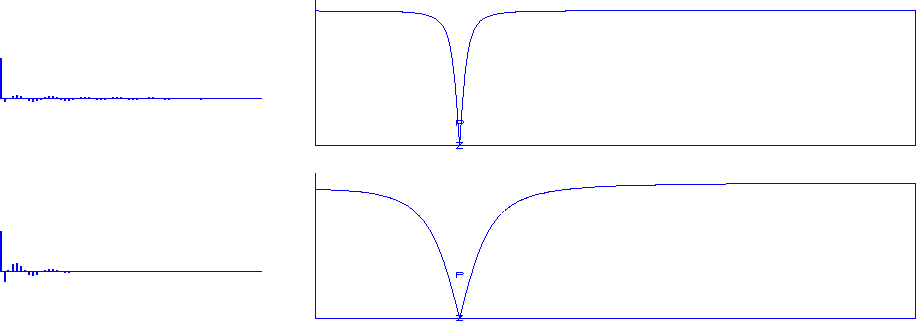




Next: PRECISION EXHAUSTION
Up: INTRODUCTION TO ALL-PASS FILTERS
Previous: INTRODUCTION TO ALL-PASS FILTERS
A ``notch filter''
rejects a narrow frequency band and leaves the rest
of the spectrum little changed.
The most common
example is 60-Hz noise from power lines.
Another is low-frequency ground roll.
Such filters can easily be made using a slight variation
on the all-pass filter.
In the all-pass filter,
the pole and zero have equal (logarithmic) relative
distances from the unit circle.
All we need to do is
put the zero closer to the circle.
Indeed, there is no reason why we should not put the zero right
on the circle:
then the frequency at which the zero
is located is exactly canceled
from the spectrum of input data.
Narrow-band filters and sharp cutoff filters
should be used with caution.
An ever-present penalty
for using such filters is that they do not decay rapidly in time.
Although this may not present problems in some applications,
it will certainly do so in others.
Obviously, if the data-collection
duration is shorter than or comparable to the impulse
response of the narrow-band filter,
then the transient effects
of starting up the experiment will not have time to die out.
Likewise, the notch should not be too narrow in a 60-Hz rejection filter.
Even a bandpass filter (an example of which, a Butterworth
filter, is
implemented in chapter ![[*]](http://sepwww.stanford.edu/latex2html/cross_ref_motif.gif) )
has a certain decay rate
in the time domain which may be too slow
for some experiments.
In radar and in reflection seismology,
the importance of a signal is not related to its
strength.
Late arriving echoes may be very weak,
but they contain information not found in earlier
echoes.
If too sharp a frequency characteristic is used,
then filter resonance from early strong arrivals
may not have decayed enough by the time
the weak late echoes arrive.
)
has a certain decay rate
in the time domain which may be too slow
for some experiments.
In radar and in reflection seismology,
the importance of a signal is not related to its
strength.
Late arriving echoes may be very weak,
but they contain information not found in earlier
echoes.
If too sharp a frequency characteristic is used,
then filter resonance from early strong arrivals
may not have decayed enough by the time
the weak late echoes arrive.
A curious thing about narrow-band reject filters is that when we
look at their impulse responses,
we always see the frequency being rejected!
For example, look at Figure 15.
The filter consists of a large spike (which contains all frequencies)
and then a sinusoidal tail of polarity opposite to that of
the frequency being rejected.
notch2
Figure 15
Top: a zero on the real frequency axis and a pole just above it
give a notch filter;
i.e., the zeroed frequency is rejected
while other frequencies are little changed.
Bottom: the notch has been broadened
by moving the pole further away from the zero.
(This notch is at 60 Hz, assuming  s.)
s.)

The vertical axis in the complex frequency plane in
Figure 15
is not exactly  . Instead it is something like the logarithm of
. Instead it is something like the logarithm of  .The logarithm is not precisely appropriate either
because zeros may be exactly on the unit circle.
I could not devise an ideal theory for scaling
.The logarithm is not precisely appropriate either
because zeros may be exactly on the unit circle.
I could not devise an ideal theory for scaling  ,so after some experimentation,
I chose
,so after some experimentation,
I chose
 ,where y is the vertical position in a window of vertical range 0<y<1.
Because of the minus sign,
the outside of the unit circle is above the
,where y is the vertical position in a window of vertical range 0<y<1.
Because of the minus sign,
the outside of the unit circle is above the  axis,
and the inside of the unit circle is below it.
axis,
and the inside of the unit circle is below it.
EXERCISES:
- Find a three-term real feedback filter to reject
59-61 Hz on data that is sampled at 500 points/s.
(Try for about 50% rejection at 59 and 61.)
Where are the poles?
What is the decay time of the filter?





Next: PRECISION EXHAUSTION
Up: INTRODUCTION TO ALL-PASS FILTERS
Previous: INTRODUCTION TO ALL-PASS FILTERS
Stanford Exploration Project
10/21/1998
![[*]](http://sepwww.stanford.edu/latex2html/cross_ref_motif.gif) )
has a certain decay rate
in the time domain which may be too slow
for some experiments.
In radar and in reflection seismology,
the importance of a signal is not related to its
strength.
Late arriving echoes may be very weak,
but they contain information not found in earlier
echoes.
If too sharp a frequency characteristic is used,
then filter resonance from early strong arrivals
may not have decayed enough by the time
the weak late echoes arrive.
)
has a certain decay rate
in the time domain which may be too slow
for some experiments.
In radar and in reflection seismology,
the importance of a signal is not related to its
strength.
Late arriving echoes may be very weak,
but they contain information not found in earlier
echoes.
If too sharp a frequency characteristic is used,
then filter resonance from early strong arrivals
may not have decayed enough by the time
the weak late echoes arrive.
